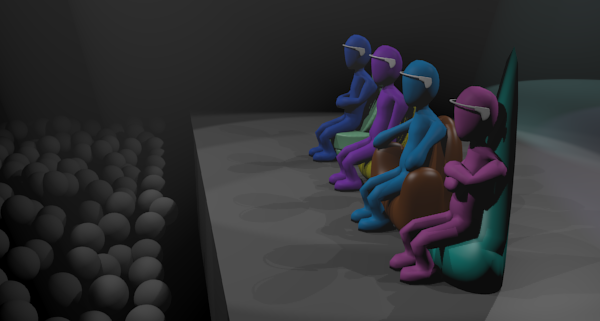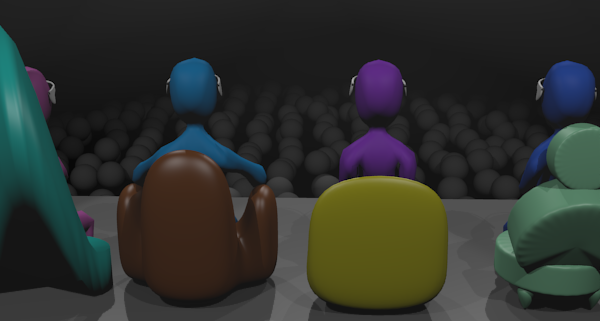Concencerto
Four performers in formalwear walk onto the stage furnished with four distinctive chairs.
Instead of librettos or instruments, they carry small headbands. They take their seats and put on the headbands, adjusting them carefully from across their foreheads to behind their ears.
They pause for a signal from the orchestra pit. After a moment, a shadowed maestro nods.
The performers relax back into their chairs, closing their eyes. The stage lights dim.
A disembodied voice speaks the first line of tonight’s narrative. In moments, an orchestral overture streams in beneath the words.
One performer sighs inaudibly, another smiles. Maestro sits motionless, monitoring a display.
Audience and performers alike lose themselves in the simple, classic drama about four characters, and the evolving themes played by the unseen orchestra. The music is…quirky, but it…somehow…plays with, and brings the narrative to life.
Intrigue in the story makes the performers shift or smirk, and brings staccato suspense in the music. Conflicts are revealed in the performers’ faces, and the interplaying strains of melody.
In time, the audience forgets that the music is entirely generated, informed by the minds of the performers and synthesized in real-time by a computer. It’s important for everyone to be as present as possible: the exact composition has never been heard before, and will never be repeated.

Technology
In Concencerto, the soloists serve as their own orchestra, and composer.
The performance is in their mentation, as a brain-sensing headband relays data streams to a high-powered computer.
Many information sources are integrated to create the score: the performers’ thought waves, data taken from their rehearsals, and cues recorded within the spoken story.
The performers’ foreknowledge of the story avoids any overwhelming surprises or triggers that could confuse the composition process. The narration is not live or continuous, but serves as another instrument guided by the performers.
Algorithms work feverishly to disambiguate the conflicting inputs and generate tempo, rhythm, harmony, and melody. Very little of the music is canned, beyond the individual notes of the instruments. Each instrument has its own way of responding to the action of the story.
The music is synthesized, using high-quality virtual instruments. While it would be possible to use a live orchestra, the music is finalized only a bar or two in advance of the moment of performance.
It’s less artificial intelligence and more codified musicality. The Maestro is there just to support the performers, and to keep an eye for glitches.

Process
Performers audition using the Muse headband, and those who are cast use the headband extensively to train their cerebral “instrument”.
As in any theatre, identification with a character from the story is the foundation of characterization: performers learn the text, and may use conventional means to prepare.
In rehearsal, performers listen to the narrative, without music, as their brainwaves are recorded and profiled. The baseline profile helps inform the software during performance.
When the live performances arrive, the artists and audience give and take energy, creating a virtuous feedback loop. It’s an opera sung through the mind, and a near-literal “baring of one’s soul”.
It’s a unique, shared experience that will never be exactly repeated.
Acknowledgements
Muse helps everyone cultivate mindfulness; Interaxon is supportive of creative applications of their technology.
REAP supports students and artists in applying advanced digital media technology to new forms of creative expression.
Kirk Zurell designed Concencerto; other creative staff TBA.